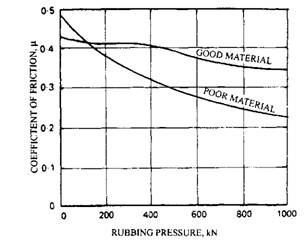28.7.
Properties of Friction Lining and Pad Materials
Friction Level.
The coefficient of friction should be sufficiently high to limit brake pedal effort. It should not be so high that it causes grab, or in the extreme cases lock or sprag. In such a situation rotation of the drum becomes impossible. The friction material must be compatible with the degree of self-energization (Fig. 28.32). The average coefficient of friction of modern friction materials is between 0.3 and 0.5.
Resistance to Heat Fade.
This property allows a lining or pad material to retain its coefficient of friction with an increase in rubbing temperature of the drum and shoes or disc and pads. A decrease in the coefficient of friction requires greater brake pedal effort and results in poor braking response. The changes in the coefficient of friction as a consequence of rising working temperatures are also partly caused by the additional curing of the pad due to chemical changes in the binder resin (Fig. 28.32). A progressive reduction in the frictional level in the higher temperature range may be acceptable. A rapid decrease in the coefficient of friction severely reduces the braking power capability specifically when the vehicle experiences long descents or continuous stop-start travel.
Recovery from Fade.
This is the ability of a friction material to return to its original friction level after cooling once brake lining or pad temperature fade has occurred. A good quality material restores its frictional characteristics on cooling, even after repeatedly subjected to severe heating. In case of an inferior material, the poor recovery is principally due to chemical breakdown in the ingredients. The friction level may be permanently altered causing hardening, cracking, flaking, and charring or even burning of the linings or pads. If the thermoplastic binder resins are used with the lining or pads a deposit may form on the rubbing surfaces, which may change the friction properties of the material (Fig. 28.32).
Resistance to Wear.
The life of a friction material, for both lining and pad, depends to a great extent upon the rubbing speed and pressure because they are responsible for material wear. The wear is also greatly influenced by the working temperature. At the upper limits of the lining or pad temperature range, the material structure is weakened, resulting in a higher wear rate (Fig. 28.32).
Resistance to Rubbing Speed.
Practically, the coefficient of friction between two rubbing surfaces slightly reduces with the increase of speed, specifically at the higher operating temperature range although it should be independent of speed. But a low quality friction material may exhibit a high friction level at low rubbing speeds and may cause judder and grab

Fig. 28.32. Effect of temperature on the coefficient

Fig. 28.33. Effects of rubbing speed on the level of friction over the temperature range.
as the vehicle tends to stop. It may also suffer from a relatively rapid decrease in the friction level as the rubbing speed increases (Fig. 28.33).
Resistance to the Intensity of Pressure.
As per the laws of friction, the coefficient of friction should be independent of the pressure holding the rubbing surface together. But present friction materials are generally compounds, which are held together with resin binders; as a result pressure between the rubbing surfaces reduces friction level to some extent. A pressure-stable lining produces deceleration proportional to the pedal effort. But a pressure-sensitive material requires a relatively greater pedal force to produce a given braking effort. Disc brakes operate better at high rubbing pressures, whereas at similar pressures
shoe linings exhibit inferior performance (Fig. 28.34).

Fig. 28.34. Effect of rubbing pressure on the coefficient of friction.

Fig. 28.35. Effects of water contamination on the materials friction recovery over a period of vehicle stops.
Resistance to Water Contamination.
Principally all friction materials to some extent are affected by water contamination. Therefore, a safe margin of friction level should be available for operation with wet conditions. Good quality friction materials should recover quickly and progressively to their original friction level during the drying out process. A poor quality material may either recover very slowly or may have over-recovery characteristic. Over-recovery tendency causes brake-grab and even wheel-lock under certain driving conditions (Fig. 28.35).
Resistance to Moisture Sensitivity.
Atmospheric dampness, humidity or dew may increase the friction level for the first few applications. They may develop the brakes noise and cause brake-grab for a short time. Moisture-sensitive friction materials should not be used with brakes having high self-energizing characteristics.
Friction Materials.
These materials generally have merits as well as limitations. Sintered metals have a long life but exhibit a relatively low coefficient of friction. Ceramics mixed with metals are very rigid, but have much higher coefficient of friction (due to which they are made in sections). They are very harsh on the drums and discs, resulting in much higher wear rates than asbestos-based materials. Friction materials have been produced containing much less asbestos and much softer metal, such as brass and zinc inserts or aluminium granules. Non-asbestos materials are now available containing DuPont’s Kevlar, a high strength aramid fiber. Some non-asbestos materials suffer from a drastic reduction in the coefficient of friction during operation in winter temperatures. Such materials may not have adequate coefficient of friction for holding overnight parking brake.
